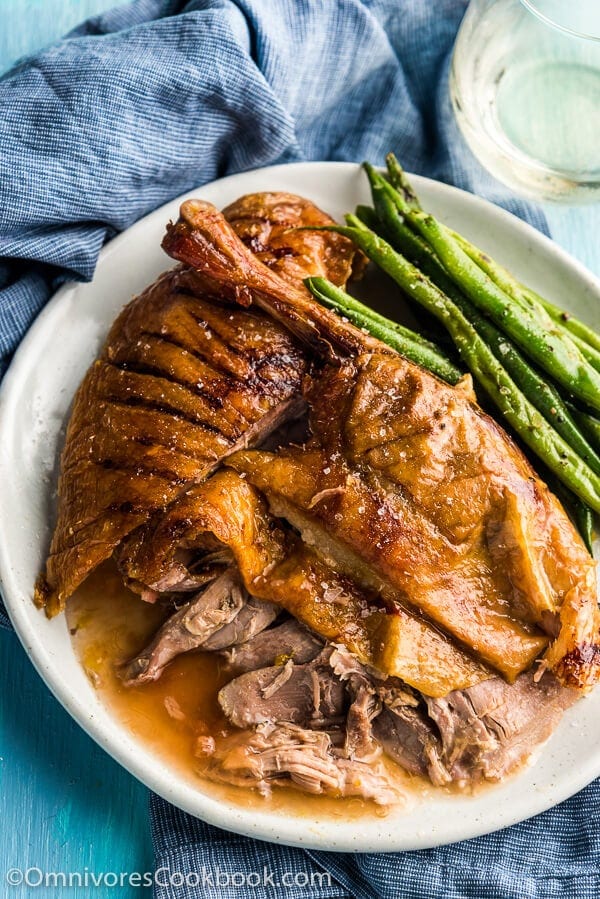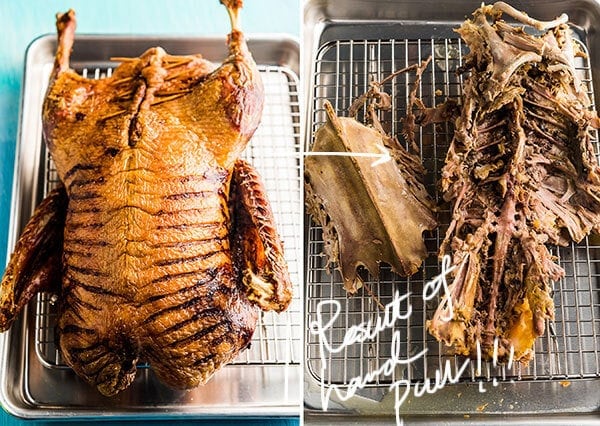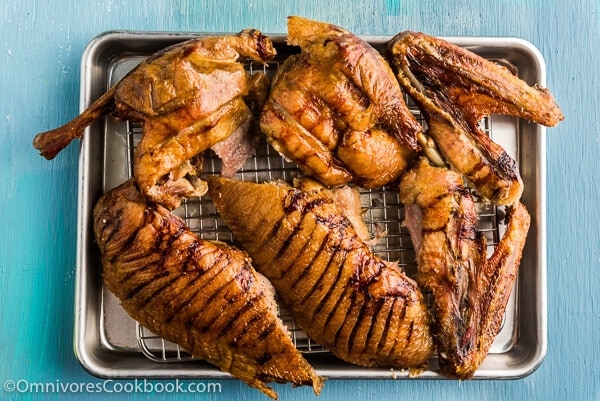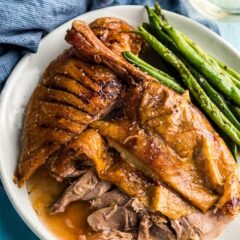
Having grown up in Beijing, I have a special attachment to duck. We’re spoiled by ubiquitous perfectly roasted Peking duck, a luxurious yet affordable dining choice that we enjoy a few times a year. I can finish half a duck myself. I enjoy eating the duck skin by itself with a bit of sauce (without the meat and without the pancake). In my world, it tastes way better than crispy bacon.
Since moving to the US, I’ve been craving duck.
The first time I dealt with a whole duck, I slow cooked it Mediterranean style. I quartered the duck, placed it on a bed of vegetables and herbs, and slow cooked it until tender. Right before serving, I crisped up the skin by heating the duck pieces under the broiler. It generated nearly duck-confit texture.
It was almost perfect, but my friend and reader Saint Phlip told me there was a better way.
The best slow roast duck
This recipe was originally shared by the chef of a hotel restaurant in Marietta, Ohio. According to Saint Phlip, it’s the tastiest duck she’s ever tried.
To cook the duck, you stuff it with several citrus fruits, then roast it at a very low temperature (95 to 120 C / 200 to 250 F). It requires a long, slow roast. But you don’t need to do anything during the roasting. No flipping, no touching.


When you’ve almost forgotten the duck, 5 hours later, you will suddenly smell a wonderful aroma coming from the kitchen. That’s when you know the duck is getting good.
The next 2 hours will be the most difficult. Your room will be filled with the wonderful roasting fragrance that reminds you of a steak house. You’ll start to check on the duck every 10 minutes, wondering why it’s still not ready. DO NOT pull out the duck now. Be patient!
When you start to worry that you’ve roasted it for too long and suspect the duck meat has lost its moisture, your dinner is ready.
You will be amazed when try to move the duck onto a carving board. You might accidentally crack the skin apart or pull a leg off. I know it’s cliche to say this, but the duck is literally fall-off-the-bone tender (as proof of my words, see the picture below). You might end up serving a “pulled duck”, since it’s nearly impossible to keep the whole thing intact. Restrain yourself from snacking on the crispy skin. You might finish the whole thing before you have a chance to serve your guests.

Cooking notes
Don’t be scared away by the long cooking time of this recipe, because:
- The active prep time is 10 minutes. And you’ll need another 10 minutes to cook the sauce and serve the duck. In total, there’s only 20 minutes of active cooking time.
- You can cook the duck one day or several days ahead, freeze the duck, and serve it later.
- If you’re serving the duck for a party, you can start roasting it in the morning, then heat it up before dinner.
Compared to roasting a perfect chicken, roasting the best duck is much easier. And it is definitely more festive.
There are a few good ways to serve the duck. In the recipe below, I introduce the original sauce recipe – a delightful and sweet sauce made from white wine and fruit preserves.
For those who miss a perfectly roasted Peking duck from back home, cook duck pancakes, and serve everything with chopped green onions and cucumbers. I guarantee you the dish will taste just like home.
For those who enjoy a savory sauce, head over to the Mediterranean duck recipe and cook the olive sauce.

Do you like my recipes? Sign up our weekly newsletter to get the latest updates delivered to your inbox and a FREE e-cookbook that contains my top 30 most popular recipes!
Chinese Cooking Made Easy
Are you new to this website? This free email series is a great place to start. I’ll walk you through a few of my most popular recipes and show you how and why they work. You’ll quickly start to cook better Chinese food in your own kitchen.

Duck de Marietta (The Best Slow Roast Duck)
Ingredients
Duck
- 1 2.5 kg / 5 to 6 pound whole duck (I used D'Artagnan Rohan Duck)
- 5 to 6 mixed citrus fruits blood orange, lemon, and/or mandarin, peels removed
- Sea salt
Sauce (*see footnote)
- 4 tablespoons jam of your choice (blueberry, apricot, etc.)
- 1 cup white wine
- 2 to 4 tablespoons potato starch (or cornstarch)
Instructions
- Adjust oven rack to the lower third. Preheat oven to 120 C (250 degrees F). Line a baking pan with aluminium foil (for easy cleanup) and top with a V-rack.
- Prepare a plate. Transfer the giblets from the duck to the plate. Use a pair of poultry shears to remove the duck neck and trim the neck skin. Do not trim any skin from the bottom of the duck, because it will keep the meat moist during roasting. Save the duck neck for making sauce or stock. Save the giblets for cooking or making stock.
- Place duck on a working surface or a cutting board. Stuff citrus inside of the duck, using as many fruits as you can. Use a few toothpicks to seal the bottom of the duck, to secure the fruits inside.
- Use a sharp paring knife to score the duck breast, about 1 cm (⅓ inch) apart. This will help the duck render fat faster and create a crispy skin. If you’re not familiar with this process, I suggest you start slow. The thickness of duck skin is not consistent. You need to avoid slicing through the meat, which will cause the duck to lose moisture. Gently press the knife. You might need to slice a few times to get the cut just right. (*see footnote 1)
- Rub both sides of the duck with plenty of sea salt. Place duck on the V-rack, breast side up.
- Bake until the skin turns golden brown, 6 to 7 hours (depending on the thickness of the duck skin). You do not need to flip the duck or monitor the process.
- (Optional) When most of the duck fat has rendered and the skin has become thin (usually 6 hours to 6.5 hours), turn up the heat of the oven to 260 degrees C (500 F) to brown the duck for another 5 to 10 minutes. This method works better when you choose a duck breed with thinner skin (or a duck that was air-chill processed). The skin will crisp up nicely and the meat will remain more juicy.
- Remove the duck from the oven and let rest for 15 minutes. Do NOT cover the duck with foil. This step further crisps up the skin. The stuffing will keep the duck meat hot.
- Transfer the duck onto a large cutting board. Carefully remove the citrus fruits (they will be very hot!) from the duck with a fork or a pair of tongs, and discard them.
- To carve the duck beautifully, you can refer to this video. Alternatively, you can simply pull the meat apart by hand.
- Transfer the rendered duck fat into a small bowl. When it has cooled off, cover with plastic wrap and store it in the fridge. Save for later use.
Option 1 - Fruity sauce
- While resting the duck, cook the fruit sauce.
- Dissolve potato starch in a few tablespoons of the white wine.
- Heat the rest of the white wine in a small saucepan until warm. Add jam of your choice. Stir and mix so that the jam incorporates with the wine. When the liquid comes to a simmer, taste it and adjust the flavor by adding more wine or jam. Remove the pan from the stove.
- Stir the potato starch slurry again to let it fully dissolve in the wine. Slowly pour it into the sauce, stirring at the same time. Add enough slurry to get the sauce to the desired thickness.
- Pour a few spoonfuls of the sauce onto a serving plate. Place the carved the duck onto the sauce. Serve warm with extra sauce on the side.
Option 2 - Peking duck
- Cook duck pancakes (or use store-bought ones). Steam to heat them up while resting the duck.
- Serve duck and pancakes with hoisin sauce, sliced green onion, and sliced cucumber.
Storage
- If you’re not serving the duck right away, wrap the meat in aluminum foil and let it cool down to room temperature. Move it to a ziplock bag, press out as much air as possible, and store it in the fridge for up to 2 days or in the freezer for up to a month.
- To reheat, place the duck, skin side up, on a roasting pan. Transfer into the oven and preheat to 260 degrees C (500 F). Bake until the duck heats up and the skin turns crispy, 10 to 15 minutes.
(Optional) Giblets
- Cut duck giblets (liver, heart, and gizzard) into even-sized chunks and combine with a spoonful of Chinese distilled liquor (白酒, bai jiu), vodka, or Shaoxing wine in a small bowl. Add a teaspoon of cornstarch and season with salt. Mix well. Marinate for 5 minutes.
- Heat oil in a skillet. Gently cook the giblets over medium low heat until cooked through and the surface browned.
- Season with black pepper and serve warm.
Notes
- Many recipes suggest puncturing the duck meat with a sharp knife or fork. I personally do not like that method so much. It is slower and the duck won’t look so pretty compared to one with scored skin.

Did you make this recipe?
I’d love to hear how it turned out for you! Please take a moment to leave a 5-star rating ⭐️ and share your thoughts in the comments further down the page. It really helps others discover the recipe too.
This is a festive dish, so we’re not going to count calories here 🙂

Esther
Maggie, I’d like to fridge dry the duck for 3 days to improve the skin. Should I score and salt/season the skin before doing this or just prior to roasting. Or should scoring and seasoning be done separately somehow? Love the flavour but my crispiness needs to improve. Many thanks.
Maggie Zhu
I’ve never tried it on the duck but I would do the score and season the skin before drying. I’ve used the same method with roasting pork belly and I always do this process before drying, and it goes improve the texture.
Esther
Thanks Maggie. I’d also thought about how I prep pork, so I think you’re on the money there.
Deborah
Fantastic ROI! But don’t discard the citrus after cooking. Instead, we made a sauce by mashing them up, added some fig jam and maple syrup (to counteract the bitterness), black pepper, pan drippings, and white wine. Awesome accompaniment!
Maggie Zhu
So happy to hear you enjoyed the dish! Thanks for sharing the tip on how to use the cooked citrus. Can’t wait to try it out next time 🙂
CHris H
This is my goto recipe for duck. But sometimes the breast is a little more dry than I like. Would brining (wet or dry) the duck work for this recipe even with the long, low cook? it works for pork shoulder!
Maggie Zhu
I have never tried brining the duck first but I’m interested in the method and think it might work. If you decided to try it out, please let me know how it goes!
wayne mccaffery
This worked just as described. Salt, Caraway seed, and fruit inside. I did 250 for 7 hours. Today I am doing 240 for 7 1/2 hours or a bit more.
wayne mccaffery
I did it except I used an ostrich…so many reviews say this, “except”. I did exactly as told. It came out exactly as promised. I have three more ducks in the freezer and each will be treated the same.
Maggie Zhu
Wow, I’ve never cooked with an ostrich. How fun! I’m glad the recipe worked out 🙂
William Bendsen
I made duck for the first time ever, in my life, and also had to transport it for 45 minutes to the host’s place.
I put a thermometer in the duck, and turned the oven down a bit, to 220. Six hours later I wrapped it up in seven layers of tinfoil, set the fat aside, and deglased the pan into a thermos. When I arrived, it was a simple matter to put the duck under the broiler until it crisped up, set it aside to rest while I made the sauce (using a cherry soda), and carving it was such a pleasant surprise – both thighs and breasts were tender and succulent.
Thank you for the clear cut recipe, which didn’t just lay out the steps, but also explained the why and how of it, and gave me the confidence to adapt the recipe to my needs.
CC
I made this recipe for Christmas and it was a masterpiece! After years of experimenting with different duck recipes and never enjoying the final result, I was excited to come across this recipe – especially after reading how easy it was. I followed the directions almost to the letter and I was blown away! I ended up having to rest the duck for 30min, (to prepare other side dishes) but it was still hot and steaming by the time my husband went to carve it. I actually screamed (with laughter and joy) and proceeded to dance around the kitchen when my husband snuck me the first bite – and not because of the romantic gesture, but because FINALLY after YEARS I had found THE recipe. It was everything I wanted and had been hoping for, it was the perfect crispy-salty-moist duck that blasts fireworks off in your mouth – something I have only experienced a few times at fancy
restaurants. Thank you Maggie Zhu and OmnivoresCookbook for sharing this recipe with the world and giving me (and my family) a recipe that we all loved and will now enjoy for many more years to come!
Maggie Zhu
So happy to hear you enjoyed the recipe and thank you for leaving a positive review! I also really love how easy this recipe is and the result has been very consistent for me. Happy Holidays 🙂
Judith Wright
Absolutely delicious and simple! Thank you
R,A, C,
Favorite duck recipe ever.
Ian
Would this work with a goose? Would there need to be any major changes besides accounting for a bigger bird? Thank you
Maggie Zhu
Yes! I actually cooked a goose before and here is the recipe: https://omnivorescookbook.com/slow-roast-goose-black-currant-sauce/ It’s pretty much the same process with a longer cooking time due to the bigger bird.
M Lauer
Outstanding! Beautiful skin and succulent meat. Thank you! Easiest and most stress-free poultry roast ever.
Jeremy
I want to try this, it sounds great. Is it 120C with or without fan?
Maggie Zhu
It is 120C without the fan.
Marian G
Hi Maggie – I’m excited to cook this duck for christmas dinner this year! Can it be done in a slow cooker or best in the oven? Thank you!
Maggie Zhu
Definitely in the oven. The skin will crisp up and becomes so tasty!
Mike Millington
This really is the best way of cooking a whole duck I have found. Simplicity itself in terms of preparation and cooking. The end result is sublime – the fat under the skin is fully rendered, the meat literally does fall off the bone, and it is so moist and tender.
Andrea
Wonderful recipe! Do you think this technique would work with duck breasts (just the breasts; not the whole duck)? I have frozen duck breasts and am used to pan searing them after rendering the fat, but they never come out as tender as I would like. I’m wondering if the slow roast method would work? They couldn’t be stuffed, obviously, but maybe laid meat-side down on top of the fruit? Any thoughts?
Maggie Zhu
I’m very interested in this approach as well. I think it might work if you properly arrange the citrus so they cover up the duck meat, to prevent it from drying out.
Re pan seared duck – it’s a totally different approach because you probably want the duck breast to be cooked until medium or medium rare for a very tender texture (I remember ordering it once when I was traveling in France. Ordered medium rare and it came out almost rare, but it was the best pan seared duck breast I’ve ever had). You need very small and thin duck breast for the pan searing to work, otherwise the meat would be tough and the skin probably too thick and fatty.
Joan Kurowski
Very delicious and directions are clear. I was intimidated to make duck but following this recipe, it was very easy. The fruity sauce was delicious as well. Thank you
Lynn Kimball Fay
Hi Maggie–I’m going to do 3 ducks, Pekin, maybe 5 pounds, not sure. I can fit two roasters side by side on one rack, but there will be no room on sides for air to circulate? But if I put one of them on another rack, I’ll have to rotate things? What changes would you suggest overall on temp/time/racks? This looks fabulous.
Maggie Zhu
I actually don’t think lack of air circulation would be a problem since the ducks will shrink a lot during the cooking (due to the fat that is rendered out). If you put them on a different rack, I would rotate the duck once or twice (I used a V-rack in my recipe so I didn’t rotate the duck at all). For the temp, I would try 275 F and you probably want to keep an eye on the time. Since this recipe uses super low temp, it doesn’t matter too much if the cooking time is a bit off.
Frances
This is now my go to duck recipe! Absolutely amazing and a hit with everyone who tries it.
My dad in particular who loves duck and is impatient for it to be done, now knows that the 7 hour cooking time is just how long it takes to be perfect!
Nivashni
Dear Maggie
Thank you so much. This recipe is wonderful. I made duck for the first time and was very nervous but this came out perfect. Crispy skin, tender, juicy. Thank you. I stuffed with cara cara oranges, lemons and mandarins and a pile of garlic. Chinese five spice powder for the outside. Marinated overnight. Will most definately make again.
anna guagliardo
Love duck. Always went to restaurant for our duck. They served it cherry sauce. I said to my husband have to get recipe for this cherry sauce. Guess what it was Comstoc cherry pie filling. Now I make duck with cherry sauce.
Russ
Hey Maggie! Question for you- I’m trying to find a balance somehow of a whole roasted duck that’s not well done but also has a crisp skin. I figured i’d give yours a try. On a whim, I checked the temperature of the breast about 3 hrs in and it was already 165 F! Is the idea that the meat will be cooked through but the slow process and rendering will mean the meat is well done but still moist? I’m a duck lover but this is only the third one i’ve roasted so still learning. Thanks!
Maggie Zhu
This recipe cooks the duck for a very long time to render off the fat from the skin and produce a tender result. It does cook through the meat, but the fat from the skin and the citrus inside will prevent the meat from drying out. The meat part is definitely not like the pan fried duck, where to barely cook it through or leave it medium rare. I’ve never measure the temperature during roasting so I cannot say for sure, but I won’t be surprised if the duck meat has reached the 165 F early on.